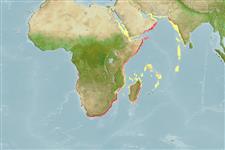Common names from other countries
>
Eupercaria/misc (Various families in series Eupercaria) >
Sparidae (Porgies)
Etymology: Diplodus: Greek, diploos = twice + Greek, odous = teeth (Ref. 45335).
Environment: milieu / climate zone / depth range / distribution range
Ecología
marino asociado a arrecife; rango de profundidad 0 - 50 m (Ref. 27121). Tropical; - 35°S
Southeast Atlantic and Western Indian Ocean: Angola to Mozambique and southern Madagascar, possibly reaching Mauritius (Ref. 3168, 3198).
Length at first maturity / Tamaño / Peso / Age
Maturity: Lm 21.1 range ? - ? cm
Max length : 45.0 cm TL macho / no sexado; (Ref. 3198); common length : 30.0 cm TL macho / no sexado; (Ref. 3507); edad máxima reportada: 21 años (Ref. 26244)
Short description
Claves de identificación | Morfología | Morfometría
Espinas dorsales (total) : 12; Radios blandos dorsales (total) : 14 - 15; Espinas anales: 3; Radios blandos anales: 13 - 14. Young specimens with fine crossbars; large adults almost uniformly black.
Adults occur in shallow rocky and sandy substrate; juveniles in shallow reefs, estuary mouths and intertidal pools, sandy beach surf zone. Omnivorous on seaweeds, sponges and bivalves. Also feeds on crustaceans, worms, mollusks, and fish. Sold fresh or whole and as bait.
Life cycle and mating behavior
Maturities | Reproducción | Spawnings | Egg(s) | Fecundities | Larva
Bauchot, M.-L. and J.-C. Hureau, 1990. Sparidae. p. 790-812. In J.C. Quero, J.C. Hureau, C. Karrer, A. Post and L. Saldanha (eds.) Check-list of the fishes of the eastern tropical Atlantic (CLOFETA). JNICT, Lisbon; SEI, Paris; and UNESCO, Paris. Vol. 2. (Ref. 3688)
IUCN Red List Status (Ref. 130435)
CITES (Ref. 128078)
Not Evaluated
Threat to humans
Harmless
Human uses
Pesquerías: escaso valor comercial; pesca deportiva: si; carnada: usually
Herramientas
Special reports
Download XML
Fuentes de Internet
Estimates based on models
Preferred temperature (Ref.
115969): 18.6 - 27, mean 25.9 (based on 56 cells).
Phylogenetic diversity index (Ref.
82804): PD
50 = 0.5000 [Uniqueness, from 0.5 = low to 2.0 = high].
Bayesian length-weight: a=0.01514 (0.00951 - 0.02409), b=3.08 (2.95 - 3.21), in cm Total Length, based on LWR estimates for this species & Genus-body shape (Ref.
93245).
Nivel trófico (Ref.
69278): 2.7 ±0.15 se; based on food items.
Resiliencia (Ref.
120179): Medio, población duplicada en un tiempo mínimo de 1.4-4.4 años (tm=3; tmax=21).
Fishing Vulnerability (Ref.
59153): Moderate vulnerability (38 of 100).
